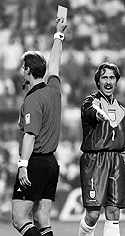Who Invented Yellow and Red Cards?
Ken Aston
The Inventor of Red and Yellow Cards
One cannot imagine modern football without the yellow and red card, terms that are now even used in the proverbial sense.
They were "invented" 35 years ago by Ken Aston, an Englishman who sadly passed away in October 2001, having made invaluable contributions to football and to the art of refereeing in particular. Teachers must perform many roles in their profession and not just within the confines of the classroom.
In England, where sport has always been an important part of the school curriculum, teachers often assume the role of the referee. Kenneth George Aston did just that in Essex in 1935. He had just turned 20 and was new to the world of teaching, when he was asked to take charge of a football match. It is probably fair to say that his pupils were more disciplined than the players at the FIFA World Cup™ in Chile (1962) or in England (1966).
Defining moments
Aston clearly enjoyed his time in the middle, and in 1936, he qualified as a referee. According to his obituary in the London daily newspaper The Times, by the start of the 1960s, Aston had worked his way up the referees’ ladder, and was undoubtedly one of the top officials in the country. His work was seldom tainted by controversy. But that was to change dramatically at the 1962 FIFA World Cup™ in Chile.
Aston was given the honour of refereeing the opening game between the host nation and Switzerland (3-1), a game that he controlled impeccably. Impressed by his performance, FIFA decided to name Aston in place of the original referee for the match between Chile and Italy, as they saw the Englishman as an experienced and reliable figure. Aston himself was not exactly overjoyed by FIFA’s decision, as the build-up to the match suggested the game would be a volatile one. Chilean newspapers claimed that Italian journalists had penned articles that cast doubt upon the beauty and morals of Chilean women. The emotionally-charged game had now become a matter of honour, and the football itself was only a secondary issue in the now infamous "Battle of Santiago". "I wasn’t reffing a football match, I was acting as an umpire in military manoeuvres," he was to remark in later years.
He was no stranger to conflict, having served in the Second World War as a lieutenant-colonel in Asia. But the nature of the game in Santiago merely confirmed everybody’s worst fears. Armed police had to enter the field of play on three separate occasions to help the referee to restore order. Aston sent off two Italian players, and had to break up a number of scuffles and fights on the pitch. The host nation eventually ran out 2-0 winners. In 1963, Aston refereed the FA Cup Final, and subsequently retired from officiating matches.
Three years later, FIFA came calling, and invited him to join their Referees’ Committee, which he chaired from 1970 to 1972. His new role at FIFA would see Aston involved yet again in one of the most controversial moments in FIFA World Cup™ history. In 1966, hosts England met Argentina in the quarter-final at Wembley, and Aston, who was in charge of refereeing at the tournament, had to use all of his diplomacy and powers of persuasion to calm down the Argentine captain Rattín after his sending off, and to prevent the match being abandoned.
The controversial game also took on greater significance when match reports in newspapers claimed that the referee had booked both Charlton brothers, Bobby and Jack. Apparently, the referee had not indicated this publicly, and England manager Alf Ramsey approached FIFA for clarification. It started a train of thought in Aston’s head too. He began to think about ways to avoid such problems in the future. "As I drove down Kensington High Street, the traffic light turned red. I thought, ’Yellow, take it easy; red, stop, you’re off’."
A born teacher
Yellow and red cards were introduced at the 1970 FIFA World Cup™ in Mexico, and have since become part and parcel of the game. But we would be doing Mr. Aston a great disservice if we limited his influence on refereeing and football to his famous brainwave. Aston was a born teacher, and spent most of his career at Newbury Park County Primary School in Essex.
As an instructor for FIFA and other organisations, he was also able to pass on his knowledge and experience over the years. He was a respected authority on the Laws of the Game, and he even appeared in court to advise on the question of whether two players had had their careers ended prematurely by reckless tackles. Football remained his life though. "I know I’m a bloody old fool," he once said when admitting that football was still in his blood.
Between 1980 and 2001, Aston held numerous referees’ courses in the USA, and was overjoyed to see that he had made a significant contribution to the game in America. As a direct result of his efforts in the USA, Aston was awarded the MBE (Member of the Order of the British Empire) in 1997. But he did not approach football or refereeing in the style of a headmaster determined to instill discipline. "The game should be a two-act play with 22 players on stage and the referee as director," he once said of his philosophy. "There is no script, no plot, you don’t know the ending, but the idea is to provide enjoyment."
Aston passed away on 23 October 2001 at the age of 86. But with his "invention", he has ensured that the villains in today’s game are clearly identified and punished – for all to see.
Reprinted with permission from www.FIFA.com

